From Legacy to Leading-Edge: The Transformation of Workflow Through Automation, Quantitative Methods, and Artificial Intelligence.
In computational paradigms, the utilization of binary encoding is fundamental for the interpretation of human-computer interfaces, specifically in registering peripheral inputs such as mouse maneuvers and keyboard actuations. This binary representation is pivotal in the underpinnings of programming logic, which is instrumental in transmuting tasks that were historically contingent upon direct human interaction into automated sequences. The advent and integration of artificial intelligence algorithms have further propelled this paradigm shift, enabling the replacement of numerous human-centric roles with more algorithmically efficient and robust computational systems.
Naturally, humans have inherent propensities for stochastic errors, bounded memory capacity, non-deterministic emotional variability, physiological constraints, and innate subjective biases, which often contributes to a decrement in operational efficiency metrics. Additionally, human behavior is often influenced by factors like fear of the unknown, job security concerns, apprehension of being outperformed, and the complexities of office politics. In organizational structures, these issues are compounded when persisting with obsolescent, legacy computational frameworks, often due to constricting regulatory compliance or financial resource allocation constraints. Additionally, a discernible national regression in academic competencies, predominantly in the domains of mathematical reasoning and literacy skills, has led to a gradual diminution in the workforce’s technical skill set.
My strategic approach is anchored in mastering complex mathematical and algorithmic models, elaborate codebase architectures, and essential elements vital for automating business process workflows. After thoroughly understanding the process, I may leverage advanced Python libraries, such as Selenium for automating web browser interactions, BeautifulSoup for HTML DOM parsing, Pandas for sophisticated quantitative analysis and data manipulation, NumPy for high-level mathematical computations, SciPy for extended scientific computing, Matplotlib for intricate data visualization, and the OpenAI suite for cutting-edge AI and machine learning models. Additionally, I may integrate Python’s ‘os’ module for efficient Windows tasks management, automate spreadsheet creation and manipulation for streamlined data handling, and explore other innovative packages. These functionalities are often encapsulated within a tkinter-based GUI, providing a user-friendly interface for interacting with complex systems.
In addition, I may employ Visual Basic for Applications (VBA) for automating Microsoft Office suite operations and Structured Query Language (SQL) for the management and manipulation of complex relational database systems. Moreover, the implementation of Microsoft Power Automate can be crucial in orchestrating and synchronizing multifaceted business processes across a broad spectrum of software applications. The strategic integration of Application Programming Interfaces (APIs), particularly those that harness artificial intelligence, can serve as a fundamental and critical element within this automation framework. APIs enable programmatic interactions between heterogeneous software applications, allowing for the seamless incorporation of external service endpoints and data repositories. This encompasses the exploitation of AI-driven capabilities for complex tasks such as natural language processing, computer vision for image recognition, and advanced predictive analytics. Furthermore, APIs that do not utilize artificial intelligence can also be effectively utilized to enhance various aspects of automation.
Through the embracement of a comprehensive perspective on business processes and the recognition of their automation potential, I have effectively automated not only substantial segments of individual tasks but also entire workflow sequences, encompassing their inception to culmination. This approach has not only optimized the allocation of time resources but also significantly mitigated operational bottlenecks. My extensive grasp of both the nuanced procedural methodologies and the advanced technological infrastructures has facilitated significant advancements in process automation, thus enhancing overall efficiency and diminishing reliance on manual human intervention. Particularly, the role of AI in programmatic debugging and error correction is remarkable, offering a level of precision and rapidity in anomaly detection and rectification that substantially exceeds human capabilities.
Implementing these strategies in your company’s operations will sharply streamline your processes, much like a diamond blade slices through solid rock. If you are interested in learning more about what automation can do for you or your business please send me a message here.

Natural Harmonic Convergence and Expansion Theory
The concept of a universal multi-function wave model, as observed in a broad spectrum of natural and human phenomena, suggests an essential pattern that permeates the fabric of existence. This model, characterized by intersecting sinusoidal waves, encompasses a vast range of processes, from the cosmic dance of star birth and death to the rhythmic pulse of ocean tides. It reflects the natural cycles of growth and decline, such as the development of a plant from a seed and parallels human experiences, like the fluctuations of emotions or the progression of learning and comprehension. The pattern is apparent in the predictable yet dynamic shifts of economic growth and recession, the escalation and de-escalation of conflicts, and the surge and ebb of creative inspiration. This wave-based model, illustrating a universal phase of intensification, peak, and diminishment, provides a framework for interpreting the interconnected rhythms of the natural world and human activity, underscoring the symmetry and cadence intrinsic to the processes that shape our reality.
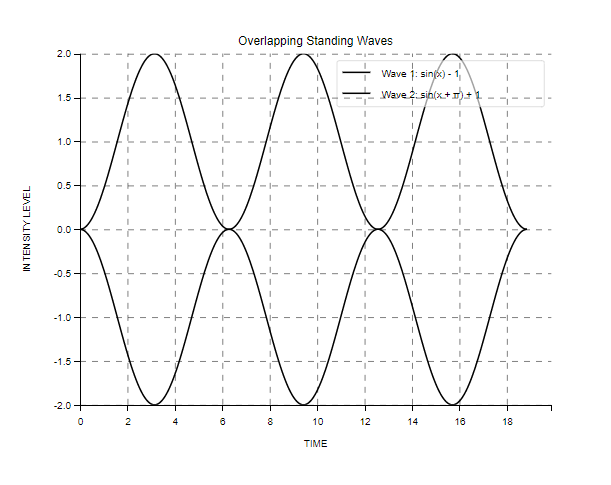
This theoretical framework hinges upon the concept of Convergence Nodes, critical points that signify stages of equilibrium within a continuous cycle. A Singular Convergence Node represents a critical juncture within a broader wave-like system, functioning as a focal point where counteracting dynamics achieve a momentary stasis. This equilibrium is characterized by the convergence of opposing cyclical motions—akin to the meeting of crest and trough in oscillatory phenomena—where they neutralize each other’s momentum. At this juncture, energies are distributed with maximal symmetry, and the system is inherently at a poised state, indicating an imminent shift from one phase to another. Essentially, this node acts as a switch point in the cycle, governing the rhythmic transition between different stages of activity or states of existence. It is comparable to the brief interlude in the respiratory process where inhalation gives way to exhalation; it is a transient interval that reflects equilibrium between the intake of oxygen-rich air and the expulsion of carbon dioxide-laden breath. This reflects the core heartbeat of any living process, mirroring the innate tempo and continuation of life-affirming cycles.
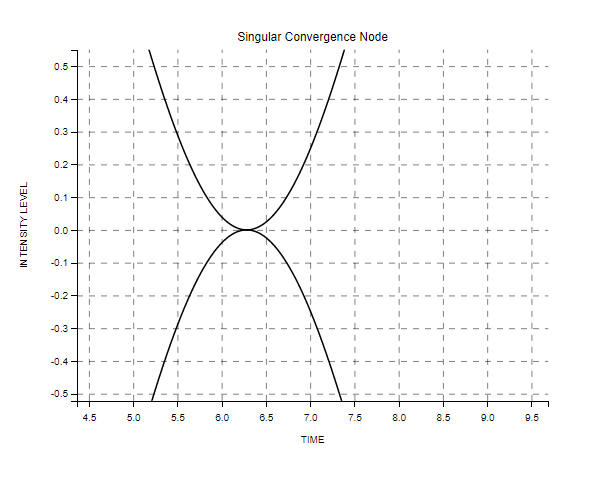
Dual Convergence Nodes represent the polar extremes—an apex and a low point—demarcating the full extent of a wave’s oscillatory path. Enclosed within these nodes is the essence of the wave’s journey, manifesting as a sequence of escalating action followed by a reciprocal diminution. This concept resonates in various domains; for instance, in ecological systems, it reflects the cycle from abundant growth in spring to the dormancy of winter. In human psychology, it parallels the journey from the heights of joy to the depths of sorrow. In the physical world, it mirrors the transition from the full moon’s brightness to the new moon’s darkness. Similarly, in artistic creativity, it can be seen as the progression from surges of high inspiration to periods of creative dormancy. The narrative encapsulated by these nodes is cyclical, encapsulating the rise and fall, the build-up to and descent from a pinnacle, which is intrinsic to a myriad of natural and human-designed patterns. Thus, the Dual Convergence Nodes provide a framework for understanding the symmetrical and rhythmic ebb and flow that characterizes the processes governing the cosmos, life cycles, and societal phenomena.
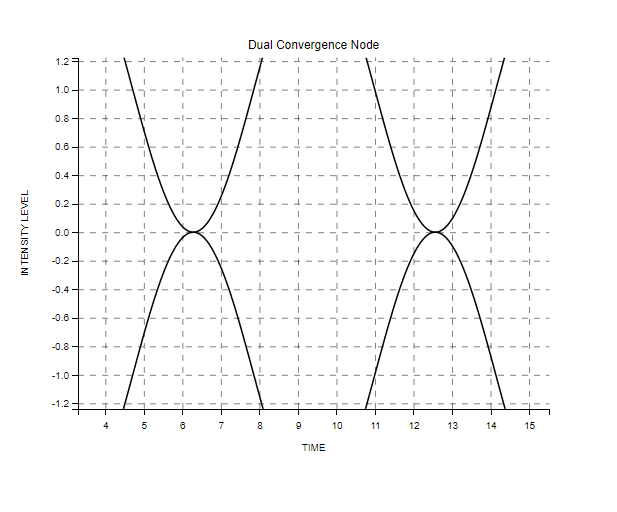
In this theoretical framework, distinct waves of activity—each represented by a different color—occur simultaneously, yet they vary in impact and reach. Consider the theoretical graph to the right, the red wave traces an individual’s lifespan, with convergence nodes highlighting personal milestones that, while significant to the individual, have a subtle ripple effect on the larger society. The green waves illustrate economic cycles; their peaks and troughs resonate more widely, affecting entire communities with booms and busts that can uplift or challenge populations. Black waves could denote long-term cultural or technological trends that evolve over decades, their convergence nodes marking pivotal shifts that redefine societal norms. Each wave follows its own timeline and bears its own influence, from the deeply personal to the broadly societal, showcasing the intricate interplay and collective rhythm of life’s many cycles. It is crucial to note that the occurrence of these waves and their convergence points may not necessarily denote equal balance within the system but rather adhere to the natural pattern of waves, where some have a more pronounced effect while others pass almost unnoticed.
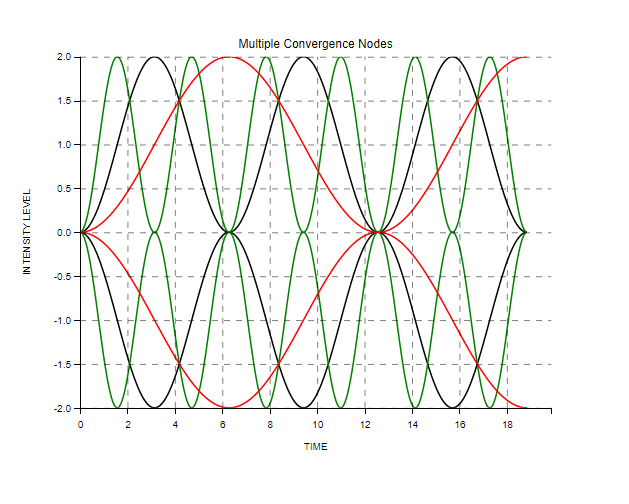
The pervasiveness of wave-like patterns throughout the various phenomena listed above—ranging from the simple act of breathing to the complex cycles of economic trends—signals an underlying mathematical order to the natural world. Mathematics, often regarded as a language of the universe, seems to transcend the confines of temporal and spatial boundaries. The existence of universal wave patterns suggests that such mathematical principles govern the rhythms and cycles not only within three-dimensional space but also, potentially, within higher dimensions that we have yet to fully comprehend. The universality and recurrence of sinusoidal waves, as identified in countless natural processes and human constructs, imply that these mathematical structures are embedded within the very fabric of the cosmos. If we consider the plurality of dimensions proposed by theoretical physics, it becomes conceivable that the wave patterns we observe may be projections or cross-sections of higher-dimensional phenomena. Thus, the wave model could be a shadow or a slice of a higher-dimensional reality, with these Dual Convergence Nodes and Singular Convergence Nodes serving as points of interface between dimensions. This enigmatic mirroring across various scales and systems offers poignant evidence for the notion that mathematics possesses higher-dimensional attributes, fundamental to the natural order.
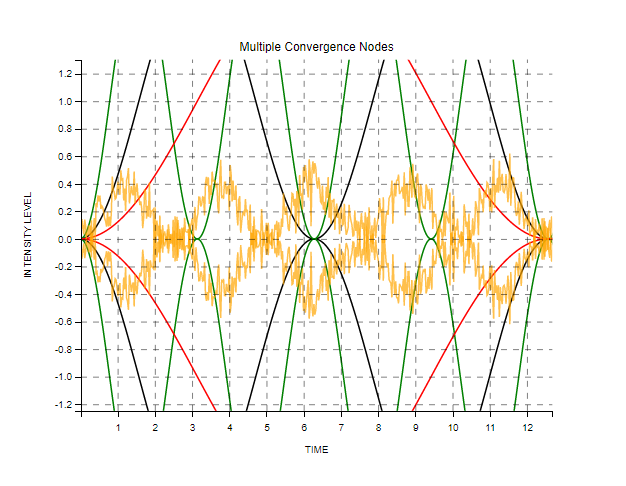
- Inhaling & Exhaling (Breathing Cycle)
- Attraction & Separation (Interpersonal Relationships)
- Seed Germination & Plant Growth (Botanical Life Cycle)
- Disagreement & Resolution (Conflict Dynamics)
- War Escalation & Peace Treaties (Geopolitical Conflicts)
- Economic Boom & Bust (Market Cycles)
- Star Formation & Supernova (Stellar Life Cycle)
- Tidal Ebb & Flow (Oceanic Tides)
- Inspiration & Creation (Artistic Process)
- Learning & Understanding (Educational Development)
- Disease Outbreak & Recovery (Epidemiological Patterns)
- Technological Innovation & Obsolescence (Tech Life Cycles)
- Exercise & Recovery (Physical Fitness)
- Sleep & Wakefulness (Circadian Rhythms)
- Emotional Highs & Lows (Psychological States)
- Seasonal Growth & Decay (Natural Seasons)
- Population Growth & Stabilization (Demographic Changes)
- Construction & Decay (Urban Development)
- Rainfall & Drought (Climatic Patterns)
- Political Rise & Decline (Political Cycles)
- Birth & Death (Life Cycle)
- Product Dev. & Market Saturation (Business Product Lifecycle)
- Creative Idea Generation & Implementation (Innovation Process)
- Water Evaporation & Precipitation (Water Cycle)
- Social Movement Rise & Resolution (Sociopolitical Movements)
- Comet Orbit & Perihelion (Astronomical Events)
- Volcanic Dormancy & Eruption (Geological Processes)
- River Flow & Flooding (Hydrological Cycles)
- Musical Crescendo & Diminuendo (Musical Composition)
- Athletic Training & Peak Performance (Sports Training)
- Soil Fertility & Depletion (Agricultural Cycles)
- Economic Inflation & Deflation (Economic Trends)
- Lunar Waxing & Waning (Lunar Phases)
- Cultural Renaissance & Decline (Cultural Movements)
- Glacial Expansion & Melting (Climatic Shifts)
- Psychological Stress & Relief (Mental Health Cycles)
- Battery Charging & Discharging (Electronic Functionality)
- Forest Growth & Wildfires (Ecological Patterns)
- Fashion Trends Rise & Fade (Fashion Industry Cycles)
- Cellular Growth & Apoptosis (Biological Processes)
- Coral Reef Flourishing & Bleaching (Marine Ecosystems)
- Real Estate Market Boom & Bust (Real Estate Trends)
- Book Publication & Literary Influence (Publishing Cycle)
- Ocean Current Strengthening & Weakening (Marine Currents)
- Language Evolution & Extinction (Linguistic Changes)
- Scientific Hypothesis & Theory Acceptance (Scientific Method)
- Legal Trendsetting & Law Reformation (Legal Evolution)
- Social Media Trending & Decline (Digital Content Lifecycle)
- Religious Movement Growth & Dissipation (Religious Trends)
- Planetary Formation & Degradation (Planetary Lifecycle)
- Economic Recovery & Recession (Economic Cycles)
- Market Supply & Demand Equilibrium (Economic Principles)
- Political Campaigns & Outcomes (Electoral Cycles)
- Sunspot Activity Increase & Decrease (Solar Cycles)
- Predator Population Increase & Prey Decline (Ecological Interactions)
- Public Interest Surge & Ebb in News Stories (Media Cycles)
- Internet Traffic Peak & Trough Times (Digital Communication Patterns)
- Thunderstorm Formation & Dissipation (Meteorological Events)
- Migration & Return of Animals (Animal Migration Cycles)
- Intermittent Fasting & Feeding (Nutritional Cycles)
- Allergy Season Onset & Offset (Health & Environment)
- Floodplain Enrichment & Erosion (Hydrological Processes)
- Automotive Innovation & Model Phasing Out (Automotive Lifecycle)
- Consumer Confidence Increase & Decrease (Consumer Behavior)
- Fitness Trend Popularity & Decline (Health & Wellness)
- Academic Semester Intensity & Break (Educational Institutions)
- Film Production & Release (Entertainment Industry)
- Daylight Lengthening & Shortening (Diurnal/Seasonal Patterns)
- Honeybee Colony Expansion & Contraction (Insect Populations)
- Venture Capital Investment & Divestment (Business Funding Cycles)
- Urban Population Growth & Suburbanization (Urban Planning)
- Crime Rate Fluctuations (Public Safety)
- Tourism Season Peak & Off-peak (Travel Industry)
- Flu Season Onset & Termination (Public Health)
- Video Game Release & User Engagement Drop (Gaming Industry)
- Stock Market Bull & Bear Phases (Investment Cycles)
- Water Table Rise & Fall (Environmental Monitoring)
- Cellular Data Usage Surge & Ebb (Telecommunications)
- Music Popularity Charts Ascent & Descent (Music Industry)
- GHG Emissions Reductions & Increases (Enviro. Policy)
- Retail Sales Boost & Decline (Retail Business)
- Human Attention Span Expansion & Contraction (Cognitive Science)
- Ocean Acidification & Alkalization Phases (Marine Chemistry)
- Material Fatigue & Failure (Engineering Materials)
- Restaurant Peak Hours & Slow Times (Hospitality Industry)
- Air Quality Deterioration & Improvement (Environmental Health)
- Commodity Price Spike & Slip (Commodity Markets)
- Mental Focus Peaks & Valleys (Psychological Functioning)
- Internet Meme Popularity Rise & Fall (Internet Culture)
- Antibiotic Efficacy & Resistance Development (Medical Treatments)
- Satellite Launch & Decommissioning (Space Industry)
- Fashion Design Conception & Collection Phase-out (Design Lifecycle)
- Employee Productivity High & Low Points (Human Resources)
- Photovoltaic Efficiency Gain & Loss (Renewable Energy)
- Monsoon Season Commencement & Cessation (Climate Patterns)
- Soil Moisture Saturation & Drying (Agronomy)
- Light Bulb Lifespan Brightening & Burnout (Electronics)
- Plant Nutrient Uptake & Depletion (Horticulture)
- Candle Lit & Fully Burnt Stages (Manufacturing)
- Competitive Market Entry & Withdrawal (Strategic Business Decisions)